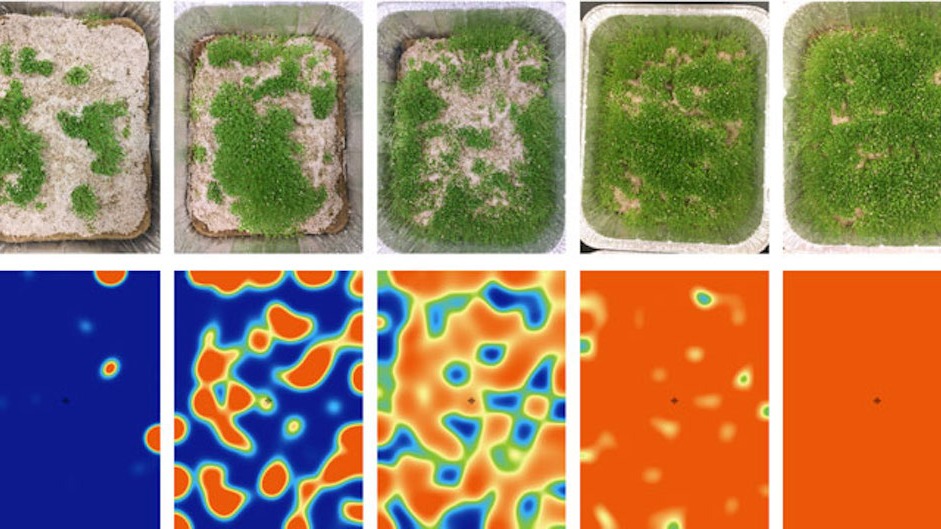Alan Turing's famous mathematical model was right all along, chia seed experiment reveals
For the first time, scientists using chia seed experiments have confirmed that Alan Turing's mathematical model can explain patterns seen in nature.

A mathematical model first proposed by Alan Turing 71 years ago may have finally been confirmed — by chia seeds sprouting in a lab.
The model may explain the chemistry behind how a zebra gets its stripes and why grasses can grow in patches.
Turing was a British mathematician perhaps best known for cracking the German Enigma code during World War II that helped lead to Allied victory over Nazi Germany.
In 1952 he suggested patterns arise in nature due to a chemical reaction between two homogeneous substances, which he described in his one and only published paper, penned while working at the University of Manchester, U.K. These patterns can be seen across numerous plant and animal species, from a zebra's black-and-white stripes to the ridges on a cactus.
Last summer Brendan D'Aquino, a computer science undergrad at Northeastern University in Boston, worked with Flavio Fenton, a professor of physics at Georgia Tech, in his lab as part of a summer internship to test Turing's theory.
Related: Newly discovered 'einstein' tile is a 13-sided shape that solves a decades-old math problem
They presented their findings at the March 7 American Physical Society meeting in Las Vegas. (The research has not been peer reviewed.)
Get the world’s most fascinating discoveries delivered straight to your inbox.
The researchers distributed chia seeds evenly in eight separate trays using different planting methods and watered them daily.
"We made sure that the seeds were spread everywhere in the trays, so it was completely homogeneous," Fenton told Live Science.
They also applied three different growing parameters to the seeds.
"We varied the amount of water each tray received and the levels of evaporation for each tray by covering half of them with Saran Wrap and leaving the rest open," D'Aquino told Live Science. "We also planted the seeds in different types of substrate, including a thick coconut fiber that represents low diffusivity, since it's harder for the water to move around, and paper towels where the water can diffuse faster."
They then let nature do the rest.
Within a week, they began seeing patterns emerge resembling those found in natural environments, such as in fields of vegetation or imprinted on an animal's fur.
The researchers found that the amount of water and evaporation affected the creation of the patterns and how pronounced they appeared.
"There were some sweet spots," D'Aquino said. "If you have too little water, then you get no vegetation, but if you have too much then you get a forest."
What they were witnessing was similar to computer simulations they had created using Turing's model, but with vegetation.
"We wanted to see if the patterns actually emerged," D'Aquino said. "To see it physically happen is really cool."
The researchers also found that the amount of water and evaporation affected the creation of the patterns and how pronounced they appeared.
Fenton added, "The patterns emerged because of this diffusion and growth."
Natasha Ellison, a mathematical ecologist and postdoctoral associate at Mississippi State University, who was not involved in the experiment, said that Turing patterns are all around us in nature and you just need to know where to look.
"Turing patterns are seen in vegetation all over the world,” Ellison told Live Science in an email. “It is fantastic to see these being recreated in laboratory settings.”
She added, “Scientists are only just finding specific chemicals and signals inside biological systems that explain these visual patterns, and by varying the amount of chemicals in both laboratory settings and in the corresponding mathematics, we are able [to] show there is some truth in Turing's theory. The work here by Fenton et al on chia seed patterns is a great example toward showing that Alan Turing really did have a remarkable genius for explaining the natural world."
The researchers plan to eventually turn their experiment into a paper.
Jennifer Nalewicki is former Live Science staff writer and Salt Lake City-based journalist whose work has been featured in The New York Times, Smithsonian Magazine, Scientific American, Popular Mechanics and more. She covers several science topics from planet Earth to paleontology and archaeology to health and culture. Prior to freelancing, Jennifer held an Editor role at Time Inc. Jennifer has a bachelor's degree in Journalism from The University of Texas at Austin.


